Projects at the University of Strathclyde, Glasgow 2008 - 2013
Many of these projects are joint work with other members of the Mobiquitous
Lab, which I co-led with Dr. Mark Dunlop, or joint teaching supervision with
Dr. Mark Dunlop or Dr. Andreas Lingnau.
Embodiment in physical data artefacts through creative
practice.
Trevor Hogan's PhD project (started summer 2011 - moved to
Bauhaus-Universitšt Weimar in 2014) investigates tangible data visualization
and the role of embodiment in the user experience of physical data artefacts,
taking a phenomenological perspective. Trevor is an external PhD student and a
lecturer at Cork Instittue of Technology in Ireland. See tactiledata.net We
have a number of shared publications, for example at HAID'12 and a paper on a
new device/installation that embodies data from a space observatory at
TEI'13.
Multimodal Interaction and Museum Learning.
Loraine Clarke's PhD project (University of Strathclyde funding) (started
Oct. 2011). As part of her PhD work, Loraine Clarke built an installation for
the 'Awakening Curiosity' Exhibition in The Ark, Dublin, which was shown May
14th to August 2012. We then began to collaborate with the Riverside
Transport Museum in Glasgow on evaluating some of their new installations and
recently on the development of novel installation ideas.
Painting Patterns for Nature
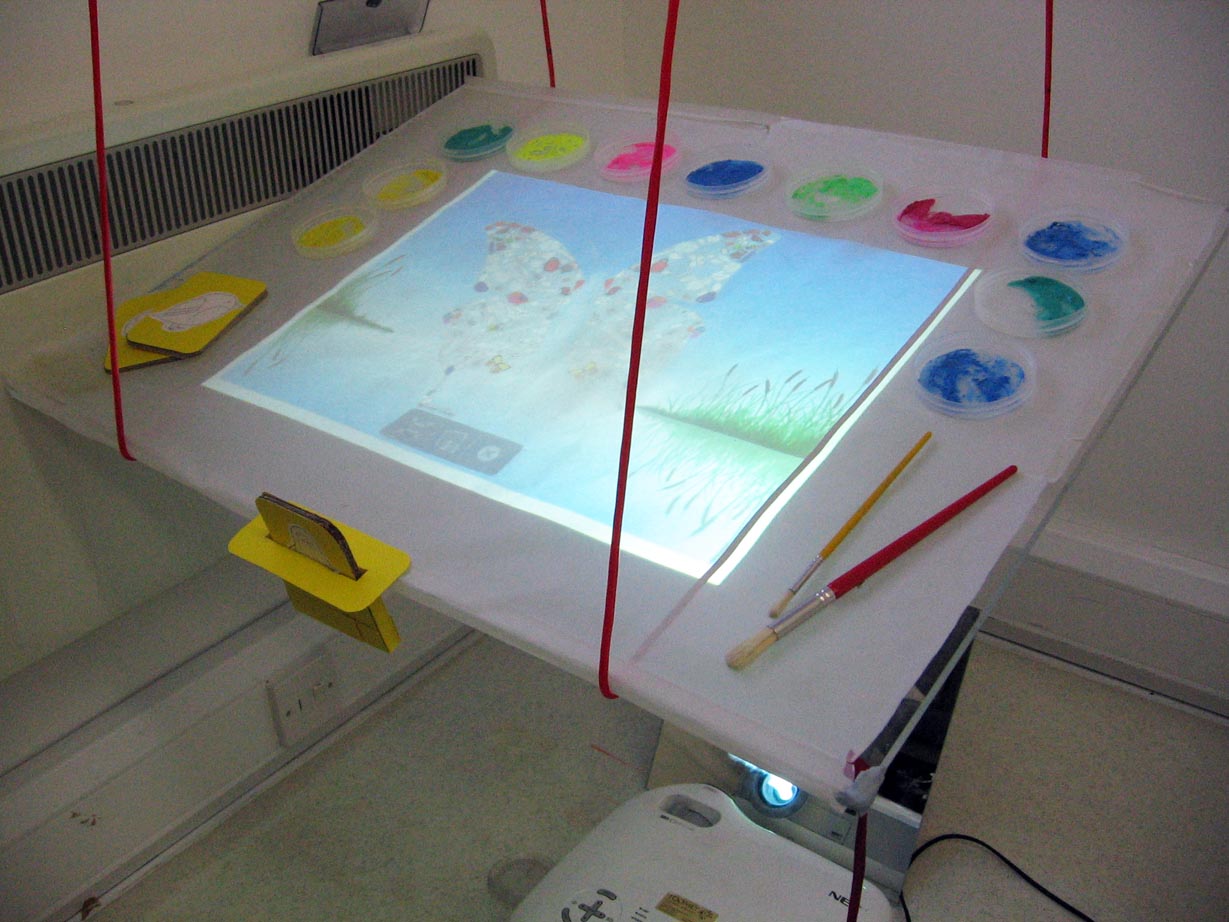 As part of
her PhD work, Loraine Clarke built this installation for the Awakening
Curiosity Exhibition in The Ark, Dublin, May 14th to August 2012. Children aged
5+ can colour in templates of various living organisms by painting with a
paintbrush on a tabletop screen, and selecting colours by dipping it into
physical paint pots. Templates are picked by selecting from a selection of
physical tokens and inserting it into the table.
As part of
her PhD work, Loraine Clarke built this installation for the Awakening
Curiosity Exhibition in The Ark, Dublin, May 14th to August 2012. Children aged
5+ can colour in templates of various living organisms by painting with a
paintbrush on a tabletop screen, and selecting colours by dipping it into
physical paint pots. Templates are picked by selecting from a selection of
physical tokens and inserting it into the table.
he in-situ evaluation of this installation has recently been published at
BritishHCI 2015. A particular theme of our findings concerns how the physical
token templates supported other members of family groups to pre-plan and
negotiate their activities, and how the physical setup and distribution of
tangible inputs enabled the 'painting' child to control access, resulting in
fairly little conflict around the table
UbiComp and Urban Space.
Patrick Tobias Fischer's PhD project investigated interaction in urban space
and exploring how to support 'urban encounters'. Tobias builds and evaluates
installations for urban spaces and had a SICSA scholarship. (2009 -2013). He
took a longer break for a Microsoft Research internship and some travels at a
point.
In his opinion urban settings frame social behaviors; but how should HCI
anticipate that fact? How should HCI deal with public and semi-public space
which is highly dynamic and complex? Tobias work aims to foster urban shared
encounters, and to investigate design criteria for this problem space.
Tobias work has resulted in publications at BritishHCI'10, TEI'10, TEI'13,
and CHI'12 about his installations and the role of space for urban
installations. He defended his theses in early 2015.
Rokka Spot
Tobias Fischer is developing an urban intervention to explore people's
reaction to an interactive object on a plaza that asks them to interact with
the space around them. This project in collaboration with Mike Anusas from DMEM
was funded by a BTG researcher-led investigation grant.
"Wi' gleesome touch!" A user study of touch interfaces for families
for the new Robert Burns museum
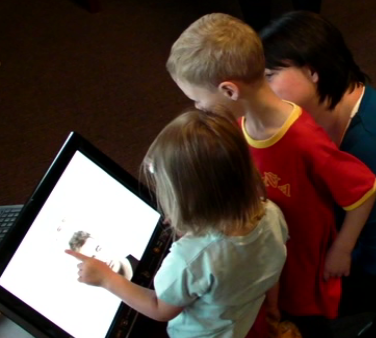 Over the summer
of 2010 we conducted an evaluation study of touchscreen installation prototypes
for the new Robert Burns Birthplace
museum in Alloway, Ayrshire. Our research informed the design of the final
systems and is funded by the National Trust Scotland. The target audience for
the museum are British young families and so-called 'empty-nesters' and we
solicited study participants from this demographic to participate in the
evaluation sessions as a group. PhD student Emma Nicol worked on the project
with Eva Hornecker and Mark Dunlop. We then did follow-up observational studies
in the RBB museum, and compared user behaviour patterns between the user study
(lab-style setting) and the in-the-wild behaviour in the museum, focusing on
family interaction.
Over the summer
of 2010 we conducted an evaluation study of touchscreen installation prototypes
for the new Robert Burns Birthplace
museum in Alloway, Ayrshire. Our research informed the design of the final
systems and is funded by the National Trust Scotland. The target audience for
the museum are British young families and so-called 'empty-nesters' and we
solicited study participants from this demographic to participate in the
evaluation sessions as a group. PhD student Emma Nicol worked on the project
with Eva Hornecker and Mark Dunlop. We then did follow-up observational studies
in the RBB museum, and compared user behaviour patterns between the user study
(lab-style setting) and the in-the-wild behaviour in the museum, focusing on
family interaction.
We have published from this project at the Re-thinking
Technology in Museums 2011 Conference (focus on our semi-realistic
evaluation approach), IDC 2012 (on using
children’s drawings to elicit feedback), and DIS
2012 (comparison of lab-versus-in-the-wild behaviours)
Interaction Styles and Tested Guidelines for multi-touch interaction
on maritime equipment
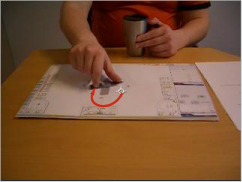 FrÝy's PhD project (funded by Rolls Royce Marine AS, Norway) investigated
human computer interaction (HCI) within the maritime environment. The focus is
on how new interaction styles can be introduced to make the interaction with
Dynamic Positioning Systems (DP) more efficient and less faulty in both
standard operations and in safety-critical situations. An initial experiment
looked into how a DP operator could operate a DP system by using bi-manual
interaction/ multi-touch combined with hand-gestures. The aim of this research
is to investigate if multi-touch will enhance safety and efficiency in DP-
operations, and enhance the user’s feeling of control.
FrÝy's PhD project (funded by Rolls Royce Marine AS, Norway) investigated
human computer interaction (HCI) within the maritime environment. The focus is
on how new interaction styles can be introduced to make the interaction with
Dynamic Positioning Systems (DP) more efficient and less faulty in both
standard operations and in safety-critical situations. An initial experiment
looked into how a DP operator could operate a DP system by using bi-manual
interaction/ multi-touch combined with hand-gestures. The aim of this research
is to investigate if multi-touch will enhance safety and efficiency in DP-
operations, and enhance the user’s feeling of control.
FrÝy passed her viva in late 2010. We continued to collaborate, as FrÝy now
establishes a martime usability lab for Rolls Royce Norway and the Mobiquitous
Lab has a consulting role on a Norway sponsored project 'Increasing Safety of
Demanding Offshore Operations through Usability'. A joint journal
paper for the Int. J. of Human-Computer Studies on FrÝy's PhD work was published
in 2012.†††††
Increasing Safety of Demanding Offshore Operations through
Usability.
User directed innovation project, collaboration with Rolls Royce Marine AS
(Norway) on establishing a maritime usability lab. This collaboration builds on
FrÝy' Birte BjÝrneseth prior PhD work at Strathclyde. Due to Eva Hornecker
leaving Strathclyde, Dr. Mark Dunlop was involved in most of the work after the
early phases.
Supporting School Children with Mobiles
Building on relationships with Alastair Wilson in Education, James Irvine in
EEE, Mark and Eva were looking into use of participatory design, social
networks and mobile support for teenagers in high schools - initially funded by
Bridging the Gap and working with Springburn Academy in Glasgow
Paintable
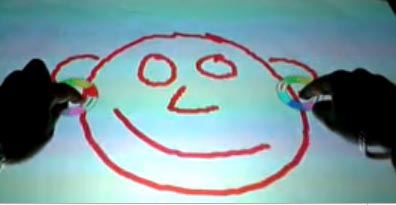 A group of
MEng students in their 5th year built an interactive surface table in the
autumn/winter semester 2009 as part of their project management course and
developed a simple graphics program to illustrate the multi-touch capabilities
of the system. PainTable is based on ReacTIVision, and thus enables multi-touch
interaction and detection of visual markers. We have since continued to work on
and improve the table.
A group of
MEng students in their 5th year built an interactive surface table in the
autumn/winter semester 2009 as part of their project management course and
developed a simple graphics program to illustrate the multi-touch capabilities
of the system. PainTable is based on ReacTIVision, and thus enables multi-touch
interaction and detection of visual markers. We have since continued to work on
and improve the table.
During summer 2009 we rebuilt the table to be more sturdy and easier to
transport (thanks mostly to Mark Dunlop), and Tobias, our PhD student along
with our intern Max spent some time investigating a better approach to
diffusing infrared LED light. Max Pfeiffer then used the table for his
internship project, developing a prototype for a Mixed Initiative Planning
Interface on the Table
TabletopTweets
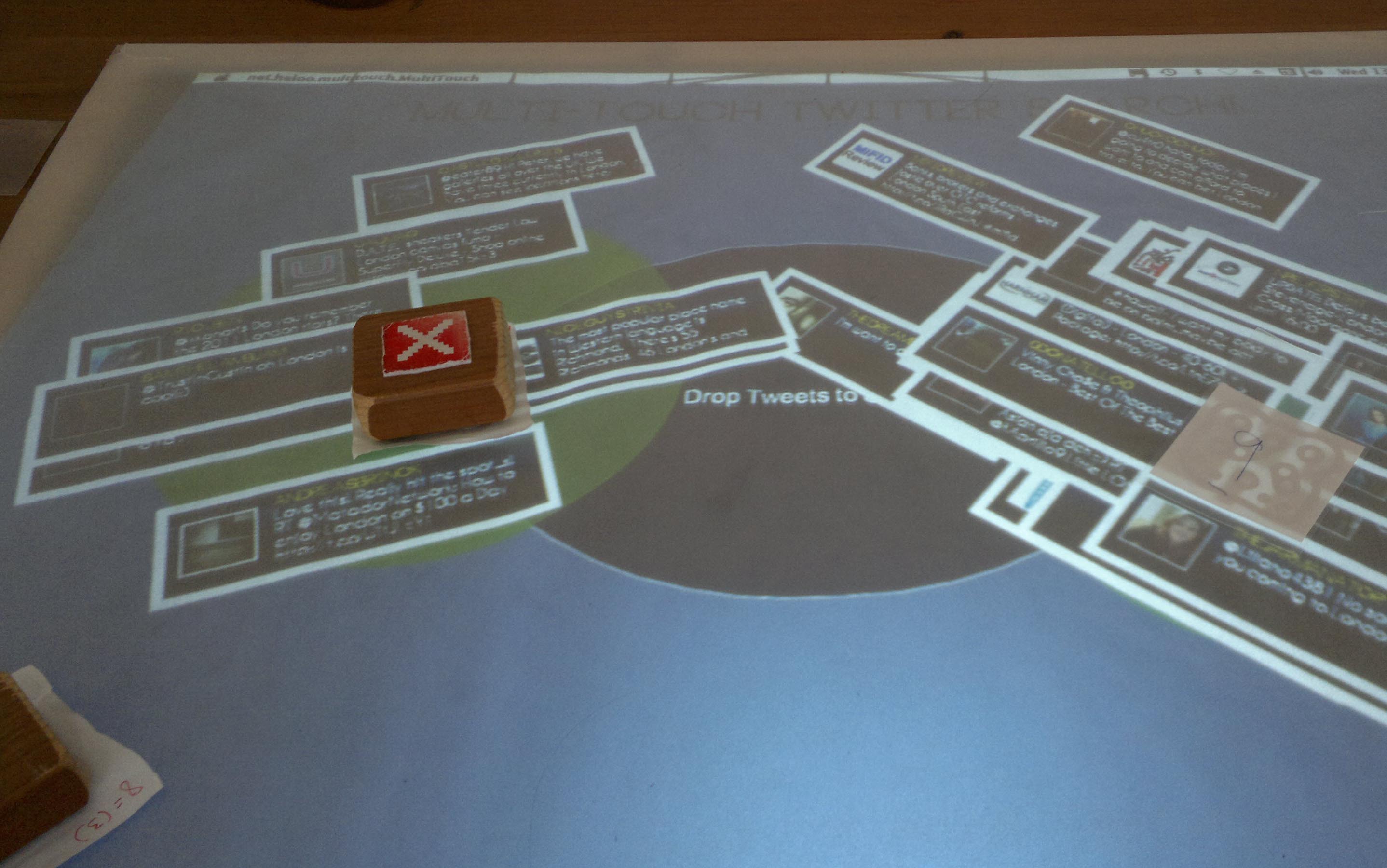 Kenneth Coyle's 2011/12 final year project (co-supervised with Andreas
Lingnau from the PuppyIR project) develops a tangible tabletop interface for a
Twitter application. We are interested in exploring non-linear views of twitter
feeds and new ways of searching for tweets.
Kenneth Coyle's 2011/12 final year project (co-supervised with Andreas
Lingnau from the PuppyIR project) develops a tangible tabletop interface for a
Twitter application. We are interested in exploring non-linear views of twitter
feeds and new ways of searching for tweets.
This work has been presented at Mensch&Computer 2013 as a poster. Kenny
has later assisted Loraine in some of the technical development for the ARK
exhibit.
t-vote: Supporting children's decision making through a tangible
tabletop application
 Carrie Mc
Crindle's final year project (2010/11) was a collaboration between the
Mobiquitous Lab and the EU PuppyIR project, co-supervised by Andreas Lingnau.
Up to 4 children can vote by placing objects with fiducials on the bottom on an
interactive table on a topic they are interested in discussing further. The
system then calculates the winning topics by counting the votes placed. The
system supports several stages of voting, iteratively narrowing down the
selection.
Carrie Mc
Crindle's final year project (2010/11) was a collaboration between the
Mobiquitous Lab and the EU PuppyIR project, co-supervised by Andreas Lingnau.
Up to 4 children can vote by placing objects with fiducials on the bottom on an
interactive table on a topic they are interested in discussing further. The
system then calculates the winning topics by counting the votes placed. The
system supports several stages of voting, iteratively narrowing down the
selection.
This work resulted in an IDC 2011 short paper and poster.
MIPT: Supporting mixed-initiative planning on a multitouch
table
 Max Pfeiffer spent Sept/Oct. 2009 as an intern at the University of
Strathclyde and developed the prototpye of an interface for Mixed Initiative
Planning on the Table, in collaboration with the Strathclyde Planning Group.
Max Pfeiffer spent Sept/Oct. 2009 as an intern at the University of
Strathclyde and developed the prototpye of an interface for Mixed Initiative
Planning on the Table, in collaboration with the Strathclyde Planning Group.
Users can manipulate tasks/activities which are allocated to timelines (e.g.
a machine, a staff member). The system calculates the resources this needs
(e.g. energy consumption) and displays this. If the changes being attempted
violate any constraints (e.g. order of tasks, time-dependencies), then the
planner system will adjust the plan automatically (or indicate that the change
is not feasible). The project investigated issues concerning direct
manipulation interfaces for planning systems and the design of multi-touch
tables for planning tasks.
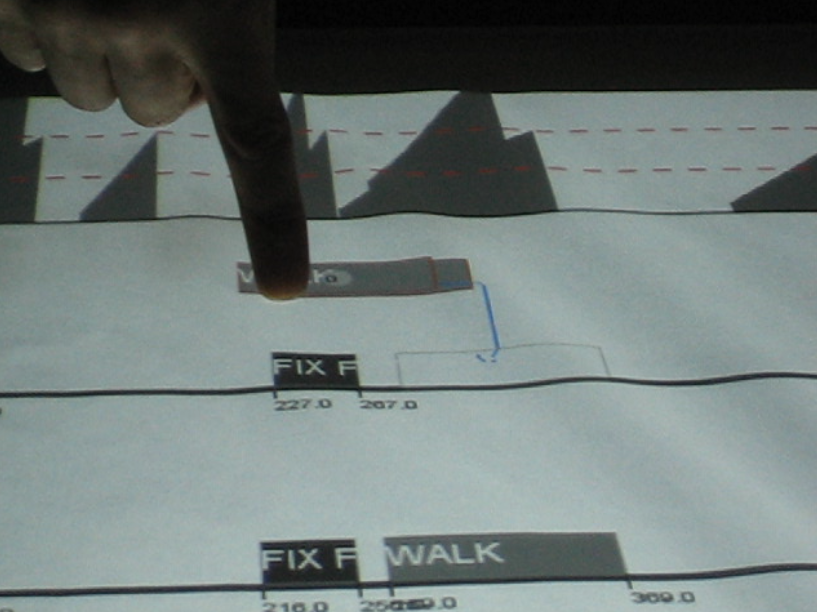

Wii Whole Body Interaction!!
 An MEng Project
team attempted to develop a whole body interaction system using wii-motes
strapped to the body in the autumn/winter semester 2010. In the end limitations
of wii technology restricted us but we succeeded in building a 5 wii-mote upper
body system. This was before the Kinect was around - at the time it was a valid
attempt, but the video clearly shows the limitations of accuracy (e.g. drift
effects) and the ridiculous setup necessary for this.
An MEng Project
team attempted to develop a whole body interaction system using wii-motes
strapped to the body in the autumn/winter semester 2010. In the end limitations
of wii technology restricted us but we succeeded in building a 5 wii-mote upper
body system. This was before the Kinect was around - at the time it was a valid
attempt, but the video clearly shows the limitations of accuracy (e.g. drift
effects) and the ridiculous setup necessary for this.
video to be included (how?)
Actuated Tangibles
Victor Lee's 2011/12 final year CES project explored the design space of
shape-shifting tangibles. The object gets larger depending on the data source
it is placed upon, activating servo motors.
video to be included (how?)
 As part of
her PhD work, Loraine Clarke built this installation for the Awakening
Curiosity Exhibition in The Ark, Dublin, May 14th to August 2012. Children aged
5+ can colour in templates of various living organisms by painting with a
paintbrush on a tabletop screen, and selecting colours by dipping it into
physical paint pots. Templates are picked by selecting from a selection of
physical tokens and inserting it into the table.
As part of
her PhD work, Loraine Clarke built this installation for the Awakening
Curiosity Exhibition in The Ark, Dublin, May 14th to August 2012. Children aged
5+ can colour in templates of various living organisms by painting with a
paintbrush on a tabletop screen, and selecting colours by dipping it into
physical paint pots. Templates are picked by selecting from a selection of
physical tokens and inserting it into the table. Over the summer
of 2010 we conducted an evaluation study of touchscreen installation prototypes
for the new
Over the summer
of 2010 we conducted an evaluation study of touchscreen installation prototypes
for the new  FrÝy's PhD project (funded by Rolls Royce Marine AS, Norway) investigated
human computer interaction (HCI) within the maritime environment. The focus is
on how new interaction styles can be introduced to make the interaction with
Dynamic Positioning Systems (DP) more efficient and less faulty in both
standard operations and in safety-critical situations. An initial experiment
looked into how a DP operator could operate a DP system by using bi-manual
interaction/ multi-touch combined with hand-gestures. The aim of this research
is to investigate if multi-touch will enhance safety and efficiency in DP-
operations, and enhance the user’s feeling of control.
FrÝy's PhD project (funded by Rolls Royce Marine AS, Norway) investigated
human computer interaction (HCI) within the maritime environment. The focus is
on how new interaction styles can be introduced to make the interaction with
Dynamic Positioning Systems (DP) more efficient and less faulty in both
standard operations and in safety-critical situations. An initial experiment
looked into how a DP operator could operate a DP system by using bi-manual
interaction/ multi-touch combined with hand-gestures. The aim of this research
is to investigate if multi-touch will enhance safety and efficiency in DP-
operations, and enhance the user’s feeling of control. A group of
MEng students in their 5th year built an interactive surface table in the
autumn/winter semester 2009 as part of their project management course and
developed a simple graphics program to illustrate the multi-touch capabilities
of the system. PainTable is based on ReacTIVision, and thus enables multi-touch
interaction and detection of visual markers. We have since continued to work on
and improve the table.
A group of
MEng students in their 5th year built an interactive surface table in the
autumn/winter semester 2009 as part of their project management course and
developed a simple graphics program to illustrate the multi-touch capabilities
of the system. PainTable is based on ReacTIVision, and thus enables multi-touch
interaction and detection of visual markers. We have since continued to work on
and improve the table.  Kenneth Coyle's 2011/12 final year project (co-supervised with Andreas
Lingnau from the PuppyIR project) develops a tangible tabletop interface for a
Twitter application. We are interested in exploring non-linear views of twitter
feeds and new ways of searching for tweets.
Kenneth Coyle's 2011/12 final year project (co-supervised with Andreas
Lingnau from the PuppyIR project) develops a tangible tabletop interface for a
Twitter application. We are interested in exploring non-linear views of twitter
feeds and new ways of searching for tweets. Carrie Mc
Crindle's final year project (2010/11) was a collaboration between the
Mobiquitous Lab and the EU PuppyIR project, co-supervised by Andreas Lingnau.
Up to 4 children can vote by placing objects with fiducials on the bottom on an
interactive table on a topic they are interested in discussing further. The
system then calculates the winning topics by counting the votes placed. The
system supports several stages of voting, iteratively narrowing down the
selection.
Carrie Mc
Crindle's final year project (2010/11) was a collaboration between the
Mobiquitous Lab and the EU PuppyIR project, co-supervised by Andreas Lingnau.
Up to 4 children can vote by placing objects with fiducials on the bottom on an
interactive table on a topic they are interested in discussing further. The
system then calculates the winning topics by counting the votes placed. The
system supports several stages of voting, iteratively narrowing down the
selection. Max Pfeiffer spent Sept/Oct. 2009 as an intern at the University of
Strathclyde and developed the prototpye of an interface for Mixed Initiative
Planning on the Table, in collaboration with the Strathclyde Planning Group.
Max Pfeiffer spent Sept/Oct. 2009 as an intern at the University of
Strathclyde and developed the prototpye of an interface for Mixed Initiative
Planning on the Table, in collaboration with the Strathclyde Planning Group.


 An MEng Project
team attempted to develop a whole body interaction system using wii-motes
strapped to the body in the autumn/winter semester 2010. In the end limitations
of wii technology restricted us but we succeeded in building a 5 wii-mote upper
body system. This was before the Kinect was around - at the time it was a valid
attempt, but the video clearly shows the limitations of accuracy (e.g. drift
effects) and the ridiculous setup necessary for this.
An MEng Project
team attempted to develop a whole body interaction system using wii-motes
strapped to the body in the autumn/winter semester 2010. In the end limitations
of wii technology restricted us but we succeeded in building a 5 wii-mote upper
body system. This was before the Kinect was around - at the time it was a valid
attempt, but the video clearly shows the limitations of accuracy (e.g. drift
effects) and the ridiculous setup necessary for this.